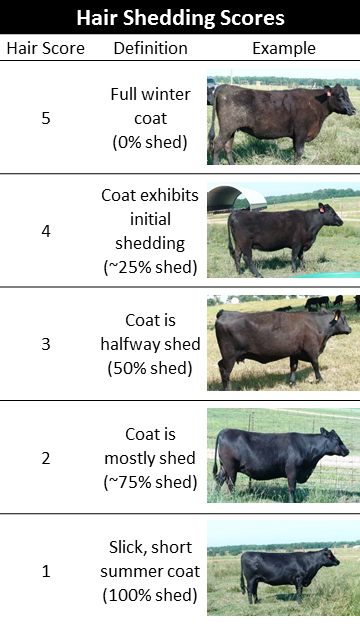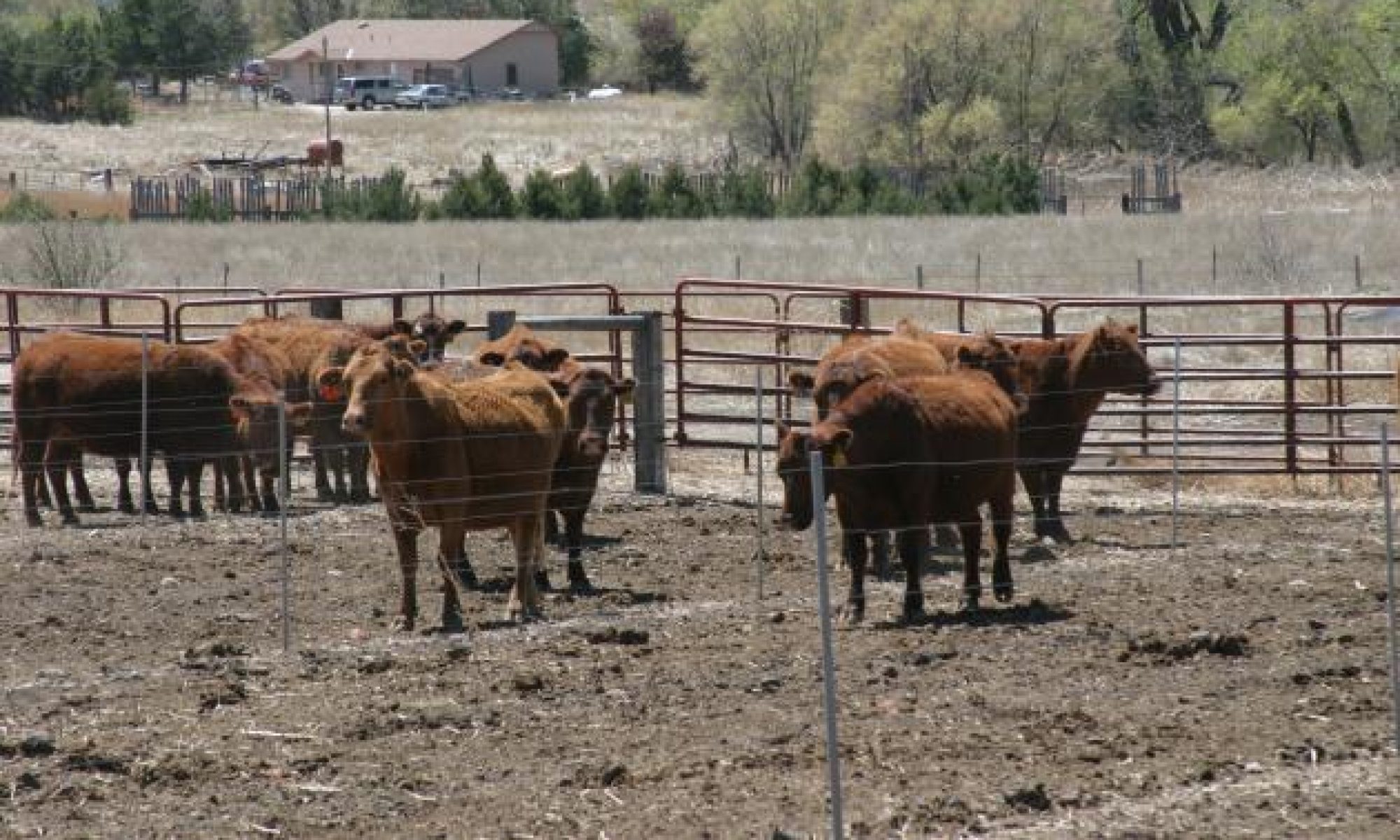 Hair shedding scores: A tool to select heat tolerant cattle
Hair shedding scores: A tool to select heat tolerant cattle
Jared E. Decker
University of Missouri, DeckerJE@missouri.edu
Jane Parish
Mississippi State University, j.parish@msstate.edu
*Click here for printable pdf.
Summary: Hair shedding scores are an easy and effective way to measure cattle’s ability to cope with heat stress. In this fact sheet, learn the how, when, and why of hair shedding scores.
Responsible beef breeding requires matching cattle genetics to production environment. This is necessary for at least three reasons: Profitability, animal well-being and improved environmental impact.
Cattle that are well-suited to their environment are more profitable. Not only are well-adapted cattle more productive, but they also require fewer inputs and interventions. It is estimated that cattle suffering from fescue toxicosis and heat stress alone cost the beef industry over a billion dollars a year.
Cattle that are adapted to their environment suffer less stress. This improves the animal’s well-being, which is important to cattle producers, beef consumers, and society. One of the greatest environmental challenges for beef producers in many parts of the U.S. is heat stress. This is especially true in the Southeast where relatively high humidity levels intensify hot temperatures in which cattle must cope to remain comfortable and productive.
Cattle whose genetics better match their environment are more effective at utilizing resources. Typical indications of cattle whose genetics do not match their environment are decreased calf weaning weights and/or failure to rebreed. Cattle whose genetics fit their production environment can increase productivity per unit of land. By efficiently using resources, cattle have a smaller impact on the environment.
Cattle raised in a profitable, socially-acceptable, and environmentally-favorable manner are sustainable. Therefore, selecting cattle that appropriately cope with heat stress is a major piece of sustainable beef production.
What tools are available to breed cattle adapted to heat stress?
One time-tested solution to produce cattle adapted to heat is to introduce Bos indicus (“eared” cattle e.g., Brahman, Nelore) or Bos indicus hybrid cattle (e.g., Brangus, Beefmaster, Santa Gertrudis, Braford, Simbrah) into a herd. Brahman-influenced cattle have advantages (anatomical and physiological) that make them better equipped to deal with heat stress. Decisions on whether or not, and to what extent, to utilize Brahman-influenced cattle in breeding programs must also consider performance levels and marketability of these cattle.
An alternative approach is to select Bos taurus cattle (British and Continental breeds) that are better adapted to heat stress. The amount of the winter coat shed by a set date during spring or summer is an effective predictor of a cow’s ability to cope with heat stress. Earlier shedding can be an indication of improved productivity and adaptation to the production environment. Hair shedding may have a direct effect on heat loss or it is possibly an indicator of another process (e.g., nutrition or immune status). Regardless, calves from cows that shed their winter coat weigh more at weaning, with some estimates as large as 24-pounds (http://dx.doi.org/10.1016/j.livsci.2011.02.009). Cattle with enhanced ability to shed hair may also have improved thermoregulatory capacity and potentially tolerate fescue toxicosis better (http://dx.doi.org/10.2527/ssasas2017.080). Initial research comparing the effects of hair coat shedding and hair coat color on heat stress signs in beef heifers suggests that hair shedding may have a greater influence on heat stress realization than hair coat color (http://dx.doi.org/10.2527/ssasas2017.068).
Early research into hair shedding indicated large portions of the variation was due to genetic differences (high heritability estimate, h2 = .63). In this early research, a strong genetic relationship between hair shedding and growth rate was observed in British cattle (but not detected in Brahman cattle). More recent estimates of hair shedding score heritability are more moderate (h2 = .35). In mild and temperate environments, no relationship between hair shedding and growth is observed; however, in hot and humid environments, cows that shed earlier have calves with heavier weaning calves.
Hair shedding scores
Hair shedding scores are simply a visual appraisal of the extent of hair shedding by a trained observer and are reported on a 1 to 5 scale (Figure 1). Half scores, such as 3.5, are not reported. A score of 5 indicates an animal that retains its complete winter coat and exhibits no evidence of shedding. At the other end of the scoring scale, a score of 1 is given when cattle have completely shed their winter coat and exhibit a slick, “summer” hair coat.
Whereas, scores of 1 or 5 are readily apparent to even a casual observer, intermediate scores from 2 to 4 must be determined according to the following standards. A score of 3 is representative of cattle that have shed approximately 50% of their winter hair coat; this is essentially the halfway point in the hair shedding process. A score of 4 indicates an animal that has begun shedding but is less than 50% shed and closer to 25% shed. A score of 2 is assigned when an animal is approximately 75% shed; these cattle are mostly shed but are not yet completely shed of their winter hair coats.
Cattle tend to shed hair from the front to the back and from their topline to their belly, but there is individual animal variation in this pattern. Typically, the last spots to shed are an animal’s lower quarter above its hock and its underline. It is only necessary to collect hair shedding scores once in late spring or early summer. The date to evaluate cattle for shedding progress will vary by geographic location and environmental conditions. Mid-May has been identified as an ideal hair shedding evaluation period for cattle in the Southeastern U.S. As a rule of thumb, the more hot and humid the climate is, the earlier in the spring scores should be collected.
Hair shedding scores are easy to collect. Scores can be collected as cattle pass through the chute or when they are out on pasture. There is no need to restrain cattle for scoring. Shedding data collection is made easier by maintaining accurate lists of which cattle are in which pastures and using data recording sheets. With preparation and planning, cattle on pasture can be scored in a matter of seconds. Even after looking for cows who tend to hide in the middle of the herd, the rate of scoring averages to one cow per minute. As another approach, hair shedding score data collection can be scheduled to coincide with routine cattle handling so long as it occurs during an appropriate timeframe for the location.
Although a hair shedding genetic prediction (i.e., Hair Shedding EPD) would be the preferred method to select for increased hair shedding, these predictions are not yet available. Producers can still make improvements, although at a slower rate, using selection on actual hair shedding scores. The heritability of hair shedding has been estimated to be approximately 0.35, meaning that 35% of the variation in hair shedding is due to genetic differences. In order to develop new genetic predictions (EPD), large quantities of data are necessary. Producers interested in improving hair shedding and adaptation to heat stress should begin collecting hair shedding scores now. Seedstock producers, in particular, are encouraged to work closely with their respective breed associations to collect and report hair shedding scores to help develop future genetic prediction tools for this trait.
Beef producers in hot or humid environments should consider adding hair-shedding scores to their box of selection tools. Earlier shedding cattle are better adapted to these challenging environments. Cattle that deal with the heat and humidity stress better will be more productive. Ultimately, that helps improve the most important trait of all, profitability.
 |
| Figure 1. Hair Shedding Scores. Photographs courtesy of Dr. Trent Smith, Mississippi State University. |
